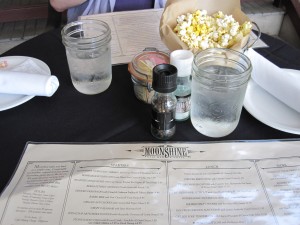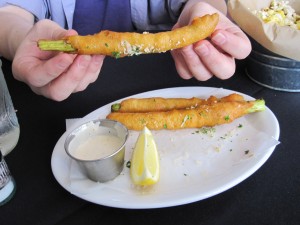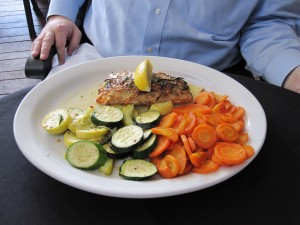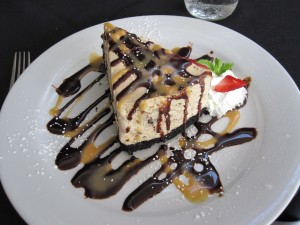You are currently browsing the category archive for the ‘Food’ category.
If I were handed a TrickyDick $300 FunBill, I would go out and try to drink 100 cups of coffee. I would fail. I would fail because, in this life, $3 coffee means the cheapest, grimiest coffee, doesn’t it? It means you spent three bucks at a gas station. It means you wasted three bucks on coffee that you won’t get around to choking down. If you have three hundred dollars and want to drink one hundred cups of coffee, your option is to make it yourself.
But not really. The fact is, there exists in Austin, a cup of coffee that runs you under a buck. I mean to find as many as I can. I mean to obtain them. I mean to try them.
Part 1: Cheating On a Halo, Also, on a Challenge
The Wells Branch Community Library
For my first trick, I shall need a volunteer from the Library. I shall need him (or her!) to go to the Wells Branch Community Library just off Wells Port Drive and obtain the first of my Cheap Coffee Cuest objects.
Library Coffee might not count. It costs exactly a dollar, though, which is what makes it my choice for first cup. They don’t actually make it there, per se. It comes from a machine. You put a little pouch bag into the device and it presses water through it, and piddles into the cup.
The library’s nice, though. I vote that it’s the nicest library on or very near Wells Port Drive.
Take that, Pflugerville Library!
Next time: Coffee that comes from a food purveyor and costs less than a dollar. Excitement!
Click: East Side Cafe of Austin
It is a common enough poetic conceit that the dog dreaming on the hearth sees himself a wolf, that the prowling housecat dreams tiger dreams, that even we common mortals of clay dream ourselves soaring as angels. If restaurants are able to dream, and if they ever closed to catch a nap, then, all the little Kerby Lanes surely dream of being the East Side Cafe.
Despite being located in the same funereal neighborhood as Hoover’s — directly across the street from it, in fact — the East Side Cafe succeeds in drawing the visitor into its own milieu right from the parking lot, where one steps out between the restaurant itself and the associated cute little garden shop, with a view across at the celebrated garden itself and a yard full of chickens.
The interior of the restaurant is entirely residential in appearance, a collection of small cozy dining rooms lined with bookshelves and, in the room where we sat, a brick fireplace supporting the daily special chalkboards. The menus display photographs on the front covers of the latest new additions or recent produce in the actual garden outside, proud as parents showing off pictures of their progeny.
And as with new parents, it is impossible for a sentient being to stay in the presence of East Side Cafe without being reminded, several times through various media, that their menu revolves around the fresh output of their actual garden outside, and it may be tempting for a minute or two to find this pride of produce a bit pretentious — but then the food arrives and justifies it entirely, even perhaps makes it seem humble.
It is, in short, damn good food.
But ‘in short’ is hardly our stock in trade here at the Bisque, so to elaborate: we began with an appetizer of Baked Brie with Apple Chutney, a generous wedge of gooey cheese more than adequate for two, the chutney an ideal complement, and violating the laws of physics that usually seem to govern this sort of dish, it arrived with exactly the right number of toasted bagel chips to actually match the amount of cheese.
James’ Dad had the Plat d’Crudities, a large platter of rabbit food, while I opted for a couple of dishes featuring combinations I would never have thought of: Smoked Salmon Ravioli with a side of Chipotle Pecan Soup. The soup, unlike many chipotle-based food items to be found in Texas, focused more on the smoky flavor of the peppers than on searing the tongue with capsacin, with a thick pureed texture suitable to a pasta sauce as much as a dish in itself.
The ravioli were roughly the size of hubcaps, and the sauce so finely tuned to complement the smoked salmon as to avoid entirely the moment of deep unease I usually hit midway through any cream-sauced seafood dish, when the stomach suddenly realizes that it is loading up on both milk and fish at the same time, even as the tongue is insisting that the rest of the serving will be joining it soon.
And afterwards, there was that which my cohort would weep should I omit to mention, to wit pie. Lime Pie in my case, and oh me, oh my. It tasted exactly like I always hope a Key-lime pie will but they so rarely do, a miraculous contradiction, simultaneously cheesecake-rich and sherbet-light. The charm of the dish was only enhanced by the use of actual cream, whipped, rather than the fluffy white emulsion sprayed from a can, and the garnish of two small pink flowers which I hope were intended as edible, since I ate one.
Charm, authenticity, amazing food and — indeed — prompt refills on the hibiscus-mint iced tea: we need to start visiting some more notably mediocre or even bad eateries, or my ratings of five humorously chosen items out of five will stop having any meaning.
But there it is anyway: five garden-fresh radishes out of five, and only a passing warning that the prices certainly reflect the establishment’s awareness of its own value.
So Texas You’ll Plotz
Click: Moonshine
Moonshine Bar & Grill is an intensely pleasant place; the interior having a homey atmosphere in the sense of resembling an actual home which happens to consist entirely of dining room, the patio spacious and airy. There is a definite feel of special occasion about the place, of which J’s D. could tell you better than I whether it wears out with repeat visits.
We had with us a guest to whom I had not been introduced, but whose presence has already become known in some of The Dad’s reviews, that being a cell-phone sized camera with capacities that would have exploded my head back in the day, which is to say this entire paragraph has been spent on ‘this review has pictures’.
Here is one, of the Moonshine’s simple yet delight-filled menu:
Note the important presence of popcorn on the table, which is brought free. It has a light dusting of some sort of peppery spice and what appears to be real butter, and even as a blatant effort to entice one toward ordering more drinks, it’s a nice touch, just the thing to nibble while considering your order.
Since the menu is only partially readable in the picture, yet I’m about to discuss it as though you know what I’m talking about, here’s a link to the website’s copy.
For my personal tastes, this menu has one of the highest percentages I’ve ever seen of things I’d actually order, so deciding between them was a bit difficult, but on the other hand, a random dart-board method would work in a pinch. We started with an appetizer of Beer Batter Asparagus:
Perhaps inevitably, including one that was, as Terry Pratchett would say, humorously shaped. The asparagus was delicious, and cooked to just the right degree to be toothsome without being mushy, which can’t be all that easy to combine with the tempura-style preparation. The beer battering, however, provided a note which would soon become a theme: the simple fact is good asparagus in batter is a bit of a gilded lily, that is, the batter did not do much to enhance the asparagus, but did make it a somewhat heavier dish, the full significance of which will become apparent.
Following that, I made a random stab at the entree list and came up with the Grilled Pork Tenderloin with Charred Pineapple & Green Chile Salsa, and a side of Baked Macaroni,
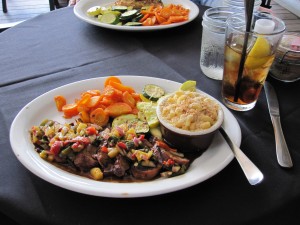
The pork tenderloin. Note the salsa, and the brown sauce which is not very visible here. They are heavy.
while James’ Dad had the Horseradish Crusted Salmon with Lemon Dill Sauce and rather than a side, opted for a double helpin’ of vegetables, on account of he has a small computer telling him how may calories he may eat in a day.
At this point I want to reiterate that the food is excellent, the service friendly and prompt (by my only particular metric, which is that I didn’t have to wait for tea refills), and the atmosphere intangibly celebratory; because for both humorous and rhetorical value this review is inevitably going to dwell on the single substantial quibble — which is, itself, a quality hard to truly complain about in a restaurant.
I use the word ‘substantially’ quite deliberately here; to put it simply, Moonshine is not a place to go if you aren’t serious about eating, unless perhaps you intend rather to sit down and get serious about drinking. The sauces are heavy, the vegetables are heavy with butter, the baked macaroni, for all that it comes in a small cup, is deliriously heavy with cheese, the asparagus is batter fried.
And the desserts…
…weigh five hundred pounds apiece.
Neither of your humble reviewers were able to finish these chocolate masterpieces, which is not a statement lightly taken. To be fair, the desserts are explicitly advertised as sized for sharing — indeed, the server warned Dr. Dad away from the Signature Skillet Apple Pie, as the serving is not a slice, but a pie (I also have to admire the sly tactic of slipping a combination dessert menu/comment card onto the table prior to bringing the check). They might do well to consider making smaller portions for people who are explicitly ordering for one.
But again, it’s hard to fault a restaurant for being too filling. It’s just not exactly a place for snackers or dieters; there are salads on the menu, but I’m willing to bet that the dressing is applied heavily, and it’s worth noting that one of the salads contains steak while another contains fried chicken. The sinister part is simply that this very filling fare will tempt you powerfully to indulge enough to spend a long time semidormant afterward.
So come hungry, leave having not quite finished a dessert.
Five Lone Stars and a shot of white lightning in a Ball jar.
I don’t know if you are a breadmaker. I thought I was. I used to make bread, I suppose. It was fine.
I put in flour and water and eggs and oil and bloomed yeast and salt and spices, and kneaded and mixed and formed and proofed and baked, and the finished product was OK. It was bread.
That’s the problem with bread, really. It touches a place in our shared biological vocabulary. It speaks to comfort and wholesomeness, and it reminds us of home, even if we came from a generation of TV dinners and gin.
But that recipe up there, that isn’t bread. Bread has four ingredients, and they are really enough. Flour, salt, water and yeast. Which is kind of like saying, cars are just steel, rubber and a computer thing. Sure, it’s true, but the way you slap them together makes all the difference in the world.
Today, I shall address what little I have learned about the world of the preferment.
Under my older method, I did a thing called “blooming” my yeast, even when it wasn’t strictly necessary. I would put the yeast in the water, often with a little sugar or flour, and let it come to life, bubbling and roiling, usually until it burned out and died. I used far too much yeast, and the product I produced was uneven, although edible.
If you take that concept of the “bloom” and simplify it, then take it out to its extreme, you get a preferment. This will often produce a substance called Poolish or biga. I am sure that there is a difference, but I am still unschooled in its nature.
Part one:
Combine one quarter teaspoon of active dry yeast with one pound of water. “Disburse” the yeast into the water. Add one pound of flour. Now, the hard part is done. You should wind up with something which could be mistaken for dough, but is not dough. It is, in fact, a bland, yellowish mixture that, if baked, will produce something kind of gross. Cover this sticky slurry with plastic wrap, and place in a cool, out-of-the-way corner.
Now, wait 12 to 16 hours.
You heard me. Let that sit, unrefrigerated, for 12 to 16 hours. Won’t it get nasty? A little, yeah, but it’s covered, and you didn’t put any fat in it, so it should be safe. You’ll know it’s ready, because it will bubble crazily, and rise into a dome. Once the dome falls, the preferment is too far gone. It’s still usable, but it will produce an odd, beery product. This isn’t always bad, but it’s not the best, either.
What does this do, this sort of souring of the dough? There are two really great effects to be had. It will produce flavors you don’t get with quicker breads. It approaches, but does not equal, the cool weirdness available from actually taking a pet sourdough starter and using it to make breads.
The time spent fermenting produces gluten. I was formerly of the opinion that gluten was formed only when bread was whumped sharply by hand or mixer, that it was entirely the product of violent action. I feel that this misconception is relatively common among young breadmakers. It is not so. Time and yeast will produce, frankly, more gluten than you can use. At the end of the fermentation process, the flour-water slurry will have taken on the consistence of old clothes or spiderwebs. It will send tendrils up when you raise the plastic wrap from the bowl. It will be very much pre-bread. It will still taste like paste, because you haven’t added any salt yet.
That can be easily remedied.
Part two:
One more pound of flour, about a tablespoon and a half of yeast, half an ounce of salt and another 7 ounces of water later, and you’re ready to mix and add your poolish. I find that this is a good chance to pull the stuff apart and really play with it a little, but I am fascinated with that kind of thing. Either way, incorporate your previous stuff with your current stuff. This is a good moment to take note: If, when you remove your poolish from its bowl, you are greeted with the distinct smell of beer, you left it a little longer. If you are confronted with library paste, you either didn’t leave it long enough, or maybe let it get too cold and should have let it grow a little longer. It’s an art, more than a science, but you want to get the stuff to the point that it will be tasty and stringy, but not too tasty or stringy.
The nice thing about this, though, is that your final dough will cover a surprising amount of beery flavor, so don’t panic too hard. You’ll be cooking this. Unless it’s started to grow Things Not Like Bread, you’re probably OK. Remember: if it is green, it is not edible. I’m sorry that doesn’t rhyme, but it is a good thing to remember. Also, if it’s white and fuzzy, it’s gross. And scuzzy? Is that better? Either way, you’ll probably notice if your preferment has gone too long.
Now, you’ve got a slightly sticky mess. Cover this bowl with plastic again, and put it in a cool place for, yes, another six hours. Four to six, I suppose. Deflate it at about one and at about three hours.
Deflate? You mean punch down, right?
No. Punching down isn’t quite right. Fold the dough. Get out the biggest of the bubbles, but don’t punch. Remove the dough to a floured surface and fold gently. This will have two potential effects. It will remove the bubbles, and it will generate a little bit of layering to the dough. No, that layering might not last once you shape the dough, but it can’t hurt, at least in my piddly little experience.
At the end of this latest, or “bench” ferment, take the dough out of the bowl. It will be glutenous and kind of sticky, and, depending on the product you desire at project’s end, you can work it as much or as little as you like. If you beat the hell out of it, you will end up with some bready rocks. If you just split off three little or two loafish chunks, and form them, you’ll get a more delicate product that will stand up to less abuse after baking. If you’re making bread for peanut-butter, go ahead and work it a little. If you’re making bread for consumption out of hand, or to just lay a slice of cheese over, you don’t really have to work it much. Dig?
Either way, after working or not, take your dough apart into two or three equal parts. I don’t like to shape, precisely, but rather to pull the outside to the bottom, sort of like making a reverse clay bowl. Pull gently and fold the pulled dough under. You should get a smooth result , with a sort of rounded bump on the bottom. Smooth this out a little, and place on either an oiled pan or a non-stick mat (or one of them fancy Baker’s Couche things, if you have one). Allow the bread to relax and rise for about another hour.
Then, into a 375 degree oven it goes (again, unless you’ve got a Couche/board arrangement, in which case, do whatever fancy thing you gotta do, there). It has been my experience that it should take about half an hour to cook through and to develop a pretty substantial crust.
Now, to steam or not to steam.
OK, not now. Now the bread’s done. This is one to think about while the oven’s preheating. Steaming produces a very different crust than failing to do so. Both are good. If you want to try it, put a pan of water on the bottom shelf, and then, just before putting in the bread, toss some water on the bottom shelf. It will make a big, dangerous steam cloud, and probably warp the bottom of your oven, unless you’ve got special equipment. This alone is the reason I don’t steam my oven. This, and the possibility that it will put out my oven flame and fill my house with deadly gas. The decision’s yours. Is the possibility that you might die worth a really outstanding crust? I say no. I say, bread is good. It’s your call.
Is there a safe alternative? Sure. Put a jelly roll sheet pan on the bottom shelf, and let it preheat with your oven. Throw the water on that, and it will steam up just fine. I mean, if you want to go that route, that’s fine. It’s not really for me, but it’s fine.
The point is, now you have some bread. You will notice two immediate improvements over not making bread that takes a whole 24 hours. First, the texture is awesome. It is markedly improved, and much more pleasing than its younger cousin. Second, the flavor is different. Is it better? I say so, but I’m also a fan of the Substance Known as Sourdough. This is an easy way to suggest it without all that pesky work, and is the only way I personally know to produce Ciabatta, but not with this recipe. That’s another time, and another set of ratios.
“I’m a pretty good pretzeler.”
— from the last words of ‘Dutch’ Schultz
This quest for the secrets of soft pretzels began more or less by chance: I wanted to bake something to eat that same night, and soft pretzels happened to be the first thing that struck my eye as a bread product which I enjoy and which wouldn’t take any kind of overnight starter or sponge. Little did I suspect that while making acceptable crispy pretzels is relatively simple, making soft pretzels appears to involve some more subtle art. As James’ Dad points out, what I’m searching for is the making of pretzels that are more akin to a bagel in consistency; whether this turns out to be a matter of recipe, preparation, or both is the riddle which the Pretzel Log seeks to unravel.
For the first entry in this series, I’m going to be using a recipe which I know doesn’t quite work — it produces crunchy pretzels which, although nice, can’t be described as soft. I’ve made several batches of these already and they’ve worked out pretty well for what they are; today I’ll be making another batch and documenting my progress as I go, to create a record of what I’m doing already, for reference as I proceed to experiment with other recipes and methods.
This recipe I tried first simply because it was the first one I found after Googling ‘soft pretzel recipe’ that didn’t call for any ingredients I didn’t have. It’s called ‘Ballpark Pretzels‘, submitted by ‘Flora’ of Columbus, OH, on the site CDKitchen.com. Strictly speaking, though, I haven’t used exactly this recipe at all — while I was mixing the first batch, the dough was too dry, and instead of adding more liquid, I decided to add two teaspoons of softened butter instead, which worked so well that I’ve made this substitution in every batch since (I was amused to learn later that this inclusion of butter matches my variation up with Alton Brown’s soft pretzel recipe).
My version of the Ballpark Pretzel recipe will be posted under LNB’s Recipe section as soon as I get around to writing it up. This post is going to be a running description of the pretzelry process as I make today’s batch.
So, first things first: 1&1/4 cups warm water, 1 teaspoon sugar and 1 tablespoon active dry yeast combined in a mixing bowl and allowed to stand for fifteen minutes or so, until foamy. One thing that does distinguish today’s effort from previous batches is that I now have in my possession a set of measuring spoons, which reveals right off the bat that I’ve been consistently underestimating the volume of a tablespoon and a teaspoon — not by very much, but I’ve definitely been underdoing ingredients measured by spoonfuls. So we’ll see what difference that makes.
While that’s sitting and fermenting, I’ll be finishing up the dishes and cleaning off the counterspace for rolling pretzels later, and also putting the two tbsp. block of butter in a Pyrex measuring cup near, but not on, a lit oven burner to soften. I’ll also be watching Naked Gun 33 1/3 on Hulu, but that probably doesn’t have any direct impact on the pretzels.
(Later – a bit more than fifteen minutes) The extra yeast has certainly made a difference in the behaviour of the ‘foamy soup’ stage — thicker and sludgier, whereas previously it had been a bit more like the head on a pint of Guiness. The next step is to mix in 1&1/2 teaspoons of salt and half the flour (2 cups) to make a dough, then turn that out onto a floured surface and knead in the remaining 2 cups of flour and the softened butter.
All right, with the dough kneaded into a firm but slightly sticky ball, I’ve put it into an oiled bowl and turned the ball over to make sure the whole thing is oiled, then covered the bowl tightly with plastic wrap. Now for another half hour or so of waiting, while the dough rises to about twice its current volume.
(Still later, about half an hour) Okay, now with the dough good and risen, here comes the effort-intensive part: splitting the dough into twelve balls, rolling them into pretzels, boiling them in a mixture of water and baking soda, and then baking them.
The boiling part is probably the part that makes the most difference in the end texture, I’m guessing. The instructions in the Ballpark recipe helpfully say to boil each pretzel ‘until it floats’, which would be a more useful instruction if they didn’t float to start with. Approximately 30 seconds of boiling seems to be the consensus among several recipes.
The Ballpark recipe also states that, after being boiled and salted, the pretzels should be allowed to rise for another five minutes before baking, a suggestion that varies from recipe to recipe (others recommend letting them rise before boiling, or omit any further rising entirely). Since it takes far more than five minutes to roll and boil a full tray of pretzels, I’m not entirely sure how to manage this step, so I’m going to let them rise for just a couple of minutes before putting the tray in the oven and see whether there’s much difference, in the end, between the ones that were boiled first and the last to go on the tray.
Final update to come when the pretzels are baked, and their quality assessed.
(Approx. 1 1/2 hours later) Okay, review time. The pretzels were baked on two cookie sheets, in batches of six; since the second six were allowed to stand while the first baked, they got more time to rise before baking. This doesn’t seem to have affected their size any, but they did emerge generally softer and with a chewier crust. On the first tray, there doesn’t seem to be any notable difference between the first pretzel boiled and the last, so overall, it seems that allowing them to rise after boiling is a good idea, but it needs around fifteen or twenty minutes rather than five.
With both trays, I took them from the oven when they had reached a much lighter brown than any previous batches, which certainly contributes to a softer interior; however, it’s still the case that the bottom side gets crispy long before the topside is even mildly browned. On the whole, both trays have turned out a little softer and chewier than previous batches, which may be due to the increased proportion of yeast, the shorter baking time, or both. However, they still don’t have a genuine soft-pretzel texture — the second, more risen tray, although softer, does not have a very distinct crust and may simply be slightly undercooked.
They are delicious, mind you, but they don’t quite have that distinctive pretzel-y flavor, and the texture, although nicely crisp on the bottom, is still not quite what I’m aiming for. Today’s batch, however, was made simply as an ‘official’ start to this blog, to make a record of where I’m starting from; future editions of the Pretzel Log will feature more deliberate experiments with assorted variables, in pursuit of the elusive Perfect Soft Pretzel. Stay twisted!

